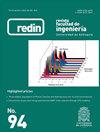Dynamic Lighting System to Increase the Attention of Design Students in the Classroom
IF 0.5
Q3 ENGINEERING, MULTIDISCIPLINARY
Revista Facultad De Ingenieria-universidad De Antioquia
Pub Date : 2021-02-06
DOI:10.19053/01211129.V30.N55.2021.12233
引用次数: 4
Abstract
Dynamic lighting is playing a key role in education, by considering the main photometric variables such as the correlated color temperature and the illuminance to increase student’s attention levels inside the classroom. In the case of design students, the project component is fundamental for teaching, where students mainly need to develop activities such as presentation to listen to the teacher instructions, ideation and sketching to propose a solution according to the problem being addressed, and exhibition to present the work that has been done. These activities require specific and adequate lighting conditions to generate a positive impact on the performance of students. This article presents the design of a dynamic lighting system capable of adjusting the correlated color temperature in a range from 2500 K to 6500 K and the illuminance levels in a range from 0 lx to 800 lx to enhance the sustained and fixed attention of design students inside the classroom according to the type of activity that is being developed. The performance of the system was 1 M. Sc. Pontificia Universidad Javeriana (Bogotá-Distrito Capital, Colombia). nieto-andres@javeriana.edu.co. ORCID: 0000-0003-1934-8552 2 M. Sc. Pontificia Universidad Javeriana (Bogotá-Distrito Capital, Colombia). j-camacho@javeriana.edu.co. ORCID: 0000-0003-1357-4858 3 Ph. D. Pontificia Universidad Javeriana (Bogotá-Distrito Capital, Colombia). rcuervo@javeriana.edu.co. ORCID: 0000-0003-4624-0678 4 M. Sc. Pontificia Universidad Javeriana (Bogotá-Distrito Capital, Colombia). edgar.hernandez@javeriana.edu.co. ORCID: 0000-0003-1692-741X Dynamic Lighting System to Increase the Attention of Design Students in the Classroom evaluated experimentally by measuring student’s attention inside the ergonomics and usability laboratory by using the Gesell chamber, the Emotiv Epoc EEG Headset with 14 electrodes to measure the brain activity and obtain engagement and focus levels, the eye tracking Tobii glasses, and a protocol to evaluate performance including several surveys and camera observation. In conclusion, the dynamic lighting system can improve the attention of design students by configuring the photometric variables according to the type of activity that is being done.动态照明系统提高设计专业学生课堂注意力
动态照明在教育中发挥着关键作用,通过考虑主要的光度变量,如相关色温和照度,以提高学生在教室内的注意力水平。对于设计专业的学生来说,项目部分是教学的基础,学生主要需要开展一些活动,比如presentation,听老师的指导,idea and sketching,根据所要解决的问题提出解决方案,exhibition,展示已经完成的工作。这些活动需要特定和适当的照明条件,以对学生的表现产生积极的影响。本文介绍了一种动态照明系统的设计,该系统能够在2500 K到6500 K的范围内调节相关色温,在0 lx到800 lx的范围内调节照度,以增强设计专业学生在教室内根据正在开发的活动类型的持续和固定注意力。该系统的性能为1 M. Sc. Pontificia Universidad Javeriana (Bogotá-Distrito Capital, columbia)。nieto-andres@javeriana.edu.co。ORCID: 0000-0003-1934-8552 2教宗雅韦里亚纳大学理学硕士(Bogotá-Distrito哥伦比亚首都)。j-camacho@javeriana.edu.co。ORCID: 0000-0003-1357-4858 3教皇大学博士(Bogotá-Distrito,哥伦比亚首都)。rcuervo@javeriana.edu.co。ORCID: 0000-0003-4624-0678 4 M. Sc. Pontificia university Javeriana (Bogotá-Distrito,哥伦比亚首都)。edgar.hernandez@javeriana.edu.co。ORCID: 0000-0003-1692-741X动态照明系统,以提高设计学生在课堂上的注意力进行实验评估,通过测量学生在人体工程学和可用性实验室中的注意力,使用Gesell室,Emotiv Epoc脑电图耳机,带有14个电极来测量大脑活动并获得参与和焦点水平,眼球追踪Tobii眼镜,以及评估性能的协议,包括几个调查和相机观察。总之,动态照明系统可以根据正在进行的活动类型配置光度变量,从而提高设计专业学生的注意力。
本文章由计算机程序翻译,如有差异,请以英文原文为准。
求助全文
约1分钟内获得全文
求助全文
来源期刊
CiteScore
2.00
自引率
0.00%
发文量
27
审稿时长
2 months
期刊介绍:
Revista Facultad de Ingenieria started in 1984 and is a publication of the School of Engineering at the University of Antioquia.
The main objective of the journal is to promote and stimulate the publishing of national and international scientific research results. The journal publishes original articles, resulting from scientific research, experimental and or simulation studies in engineering sciences, technology, and similar disciplines (Electronics, Telecommunications, Bioengineering, Biotechnology, Electrical, Computer Science, Mechanical, Chemical, Environmental, Materials, Sanitary, Civil and Industrial Engineering).
In exceptional cases, the journal will publish insightful articles related to current important subjects, or revision articles representing a significant contribution to the contextualization of the state of the art in a known relevant topic. Case reports will only be published when those cases are related to studies in which the validity of a methodology is being proven for the first time, or when a significant contribution to the knowledge of an unexplored system can be proven.
All published articles have undergone a peer review process, carried out by experts recognized for their knowledge and contributions to the relevant field.
To adapt the Journal to international standards and to promote the visibility of the published articles; and therefore, to have a greater impact in the global academic community, after November 1st 2013, the journal will accept only manuscripts written in English for reviewing and publication.
Revista Facultad de Ingeniería –redin is entirely financed by University of Antioquia
Since 2015, every article accepted for publication in the journal is assigned a DOI number.

 求助内容:
求助内容: 应助结果提醒方式:
应助结果提醒方式:


